"For
memory has painted this perfect day
whith colors that never fade ..."
Carrie Jacobs Bond
July
22, 1998
Español
To
most of us, the words "flash cards" bring to mind endless hours
of learning arithmetic, but in the world of digital cameras they have
an entirely different connotation.
There,
flash cards are small, solid-state memory devices that retain data indefinitely
without requiring power...and which record and store digital images for
retrieval or erasure at a future time.
I asked half
a dozen experts in the memory card business where the name "flash"
came from and not one of them knew. But Brandon Talaich of SanDisk, the
largest manufacturer of flash memory, finally dug out the answer for me
which included technical terms like EPROM, UV, E2erase and others. The
bottom line? Blocks of memory on these cards can be erased in a flash,
quickly clearing space for new information...hence, flash cards. OK, that’s
it for the technical stuff...on to the practical.
A SIZE FOR ALL CAMERAS
There are
three predominant types of memory cards on the market today that can
store digital camera images:
1. Full-sized standard PCMCIA (Personal Computer Memory Card
Association) cards, also known as ATA (Advanced Technology Attachment)
cards. Called simply PC or ATA cards, they measure 2.1 inches by 3.3
inches by various thicknesses...up to about half an inch.
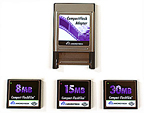
|
2. Compact Flash cards,
sized 1.7 inches by 1.4
inches .13 of an inch |
| ...Compact
flash and adapter |
|
|
3. SmartMedia cards, sized
1.8
inches by 1.5 inches .03 of an
inch. |
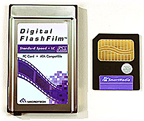
|
| |
SmartMedia card and adapter |
In
addition to PC/ATA Flash Cards you’ll also come across Linear Flash
Cards, but these are quirky little fellas and are rarely used in cameras.
Incidentally, don’t choose a camera based on the type of storage
card it uses, because despite claims by card manufacturers that "mine
is better than yours" they all work quite well.
Why, then, devote most of this column to discussing them? Because if
you use them with a PC Card Reader and an appropriate adapter, you can
transfer images to your computer in seconds...not minutes or hours.
And with higher and higher resolution cameras hitting the market today,
that’s a big advantage, especially if you’ve ever fumed and
fretted as 20 or 30 large 800k images leisurely downloaded.
"YOU´RE
JUST NOT MY TYPE"
Most laptops have full-sized PC Card slots. You can slide in a modem
card, or one that has a small hard drive built into it, a non-moving
memory card, or a card capable of video capture...in short, anything
that can be miniaturized to fit into one of three standard-sized cards
having different thicknesses.
Ranging from thin to thick they are designated as Type I, Type II, and
Type III. The Type I cards are usually used for memory, Type II for
memory or fax/modems, and Type III for hard drives that rotate and wireless
communications devices. Any lower-numbered card can fit into a slot
designed to take a larger one but not vice-versa. For example, Type
I and Type II cards can fit into a Type III slot, but a Type III card
can’t fit into a Type I or II slot.
High end professional digital cameras usually use full-sized memory
cards (sometimes two) because they come in large MB capacities and are
thus ideal for storing many high resolution images. But they’d
take up too much space in the typical slim-line consumer digital camera.
Besides, it’s unlikely you’d ever need 300MB or more of memory
because your file sizes will usually be under 1MB per picture- even
at your camera’s highest resolution and lowest (best) compression
ratio.
DÉJÀ VU...RELIVING VHS VS. BETA
Enter the Compact Flash card, now used in almost 50 camera
models and developed by SanDisk in 1994. Less than half the size of
a standard Type I card, it slips easily into a small crevice in the
camera body and can hold up to 48MB of data, more than enough for an
average shooting session. If you need more storage, pull it out and
pop in another...just like a roll of film, only a lot easier.
But digital camera life would be too simple if it all ended there; yet
another standard has evolved to be reckoned with...the SmartMedia card
or SSFDC (Solid State Floppy Disk Card). To make things even more challenging,
they come in two voltages, 3.3v (which most cameras use) and 5v (which
some cameras use), and they are not interchangeable (3.3v cards have
their upper right corner cut at 45o, 5v cards are sliced on the upper
left).
Smaller than a Compact Flash card, but larger than a postage stamp (barely)
SmartMedia cards also store images but operate differently. Presently
they only store 8MB of information but 16MB cards are imminent. Do they
have any advantages over Compact Flash? Well, yes, they’re less
expensive. A package of three 8MB cards is about $110 compared to $140
for a 24MB Compact Flash card.
MICRO-CONTROLLERS, AND MORE
But price isn’t the only factor to consider. While
every Compact Flash card is designed to standards which guarantee it
will be forward and backward compatible with present and future cameras,
SmartMedia cards may not be as versatile. A Compact Flash card is an
all-in-one package, with memory, micro-controller, and software integrated
into the card itself. SmartMedia cards must rely on a micro-controller
and software in the camera to interface with its memory.
As SmartMedia cards begin to offer more storage capacity, their complexity
may increase and updates to camera micro-controller software may be
required...which could cause incompatibilities with earlier, smaller
capacity cards. So older cards may not work with newer cameras and newer
cards may not work with older ones. Not that there’s much you can
do about it... it certainly wouldn’t dissuade me from buying the
legendary Olympus D600L just because its successors might not be able
to use SmartMedia cards currently compatible with it. Nevertheless,
its something you should know about.
PC
CARD READERS
For transferring camera images to a computer, a PC Card
Reader is the fastest way to go. Here’s how it works. Buy either
a parallel port PC Card Reader for PC or a SCSI PC Card Reader for MAC.
Depending on the memory type your camera uses, get either a Compact
Flash adapter ($15) or a SmartMedia adapter($65 or so), both of which
come in a standard Type II size. After connecting the reader to your
computer, slip your flash memory card into the adapter, insert the adapter
into the reader, and voilà...the card shows up as if it were
an auxiliary hard drive (which it is) on your monitor screen, titled:
"Untitled."
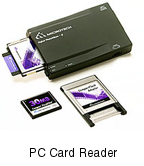 Click
it open and there are all your camera JPEG image files ready for transfer
to your hard drive. After copying them over, they’re ready to be
opened in your imaging program. Some imaging programs will even read
them directly from the PC Card Reader and import them as thumbnails...just
as if they were still in your camera which, in a manner of speaking,
they are. When you’ve completed the transfer -about a second or
two per MB- and verified that your pictures are really there, you can
erase the card and you’re ready to roll again. You can also give
it a name other than "Untitled" if you wish. Click
it open and there are all your camera JPEG image files ready for transfer
to your hard drive. After copying them over, they’re ready to be
opened in your imaging program. Some imaging programs will even read
them directly from the PC Card Reader and import them as thumbnails...just
as if they were still in your camera which, in a manner of speaking,
they are. When you’ve completed the transfer -about a second or
two per MB- and verified that your pictures are really there, you can
erase the card and you’re ready to roll again. You can also give
it a name other than "Untitled" if you wish.
One note of warning. It is physically impossible to put a Compact Flash
card into the adapter the wrong way, but it is really easy to do with
a SmartMedia Card. It will go in either right-side up or upside down.
Since it can load into your camera with the bright gold (memory) side
in any position (depending on the camera design) you may spend many
frustrating minutes wondering why it won’t mount when it’s
slid into its adapter. Just make sure the bright gold side faces up
when the adapter is positioned correctly for insertion into the card
reader.
DEDICATED CARD READERS
If you think all you’ll ever use is one type of
card, there are less expensive readers that are dedicated only to those
formats. But I like to hedge my bets...the camera I use today may be
replaced in the future by one that takes a different type of memory
card, so I recommend purchasing a full-sized PC Card Reader.
Intermart makes an excellent line of PC Card Readers, so good, in fact,
that many companies simply buy Intermart readers and privately label
them. MAC users will, of course, have to pay more for Intermart’s
PCD-10 SCSI version, but it’s well worth it and, besides, they’re
used to paying a premium to have their peripherals work without a hitch.
After replacing the PC Exchange control panel with one called Mac-PC
Manager -which is supplied with the reader- they’re ready to roll.
There’s another way to transfer SmartMedia images...through a FlashPath
adapter. The little SmartMedia card is slid into a floppy-like disk
which is then inserted into your drive. It mounts as a floppy would
and you can transfer image files directly to your hard drive. It takes
a bit longer than a PC Card Reader, but it’s convenient and less
expensive (about $99). PC drivers are now available and a MAC driver
(beta version) was demonstrated by Olympus at MacWorld, so it should
be available soon.
SPEEDY? MAYBE.
Finally, there’s much smoke polluting the air these days about
card speeds...and it’s all marketing hype. Digital camera components
are not yet capable of matching the highest speed of most cards; undoubtedly
there will be a time in the future when that will change and a speedy
card might shave a second or two off processing time, but it’s
not today. So don’t buy cards on the basis of speed tests...or
the cheapest price, either. Unlike computer memory, which comes with
a lifetime warranty, it’s usually only a year for flash cards;
however that’s changing and some cards carried by EPC-Online are
now warranteed for five years. Others may have even longer ones. Shop
around.
Granted, this hasn’t been a super-technical discussion of flash
memory storage cards, but its all you need to know to avoid becoming
confused. More technical information is available at the web sites listed
at the end of this column, and I’ve also listed some resources
for hardware, including a few deals for ZoneZero MAC users to help them
keep the MacGrumbling to a minimum about higher prices.
 SNAP
SHOTS SNAP
SHOTS
MGVISION´S DIGITAL WALLET
This is new PC-only product is the size of a couple of packs of cigarettes
and has a belt clip attached. Within its plastic case, an over-1-Gigabyte,
battery-powered hard drive hums merrily, ready to receive 99 "rolls"
of digital film. Now before you begin to laugh, the Wallet folks at
MGVision had a hard time with this because whether you transfer one
image or 100, it counts as one event, hence they settled on "rolls"
as their measure of capacity. (NOTE: They’ve just changed that
to 10,000 pictures...much better.)
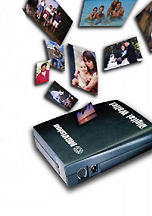 The whole point behind this unusual product is that it is supposed to
save you lots of money on memory cards. For example, when you go on
vacation you need only use the memory card that came with your camera
and, when it’s full, dump the images into the wallet, erase your
card, and use it for new pictures. The Wallet uses serial transfer,
which is slow as molasses and so you’d want to put it to work while
you went to dinner each evening. When the transfer is complete, you
hit a button and it confirms that everything went OK. Once home, you
use the supplied software to download the images from the Wallet to
your computer...better plan on a seven-course meal that evening, unless
you’ve taken 10,000 pictures, in which case a week-long feast would
be more in order.
The whole point behind this unusual product is that it is supposed to
save you lots of money on memory cards. For example, when you go on
vacation you need only use the memory card that came with your camera
and, when it’s full, dump the images into the wallet, erase your
card, and use it for new pictures. The Wallet uses serial transfer,
which is slow as molasses and so you’d want to put it to work while
you went to dinner each evening. When the transfer is complete, you
hit a button and it confirms that everything went OK. Once home, you
use the supplied software to download the images from the Wallet to
your computer...better plan on a seven-course meal that evening, unless
you’ve taken 10,000 pictures, in which case a week-long feast would
be more in order.
In theory, it’s a great idea, and when digital cameras could only
store images in internal memory, it would have been a product whose
time had come. But at $399 (about $349 on the street), and with the
cost of flash memory dropping by the minute, it could turn out to be
a product whose time has gone...at least for digital cameras. And I,
being of little faith, would always worry that it hadn’t transferred
my images intact -if at all- regardless of what it told me. Now if it
could interface to the camera’s LCD to confirm that those images
were really there- and was priced at about $199, that would be an entirely
different story...and a great one.
THE EMBERLEY DIGIPOWERPACK
You
only have to talk to Gordon Emberley (a professional photographer) for
a few minutes to determine that he’s a man possessed...with a desire
to produce the finest digital camera power pack in the world. No skimping
here, just a perfectionist who’s bound and determined to give more
power to the people...the people who use digital cameras.
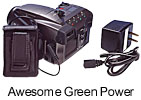 His
2.4 amp-hour battery pack is the only one that uses environmentally
safe, rechargeable NiMH (Nickel Metal Hydride) batteries that last 8-times
longer than a set of standard AA’s. They can be recharged 1,000
to 2,000 times and will just keep on tickin’ or jucin’ as
the case may be, and each has a custom cord to fit your camera model.
Even more powerful 4 and 8 amp-hour packs are coming soon, and they’ll
all double as AC power supplies so you can save a bundle there. His
2.4 amp-hour battery pack is the only one that uses environmentally
safe, rechargeable NiMH (Nickel Metal Hydride) batteries that last 8-times
longer than a set of standard AA’s. They can be recharged 1,000
to 2,000 times and will just keep on tickin’ or jucin’ as
the case may be, and each has a custom cord to fit your camera model.
Even more powerful 4 and 8 amp-hour packs are coming soon, and they’ll
all double as AC power supplies so you can save a bundle there.
Nikon CoolPix 900 owners will be ecstatic to learn that when using the
DigiPowerPack, the LCD will stay awake just as long as you’d like
it to...without taking a snooze every 30 seconds. The units are super
lightweight, starting at about 6.5 ounces and are smaller (here we go
again) than a pack of cigarettes (the tobacco industry may be trying
to kill us, but on the bright side they’ve given us a universal
unit of measure). A genuine leather case that smells like the interior
of a Jaguar XJ8 and a belt clip round out the picture. Not cheap (but
neither are Jaguars), the units will retail for $120 and up.
THE SR DIGITAL FLASH LINE
The most commonly heard lament by photographers using digital cameras
is that they don’t have external flash synch. Photographers, who
are generally esthetic types, cringe at the pasty faces and inky shadows
produced by on-camera flash. So one of the first things they do is rig
up a diverter to put over the camera’s flash and buy a slave trigger
to attach to an external strobe. When the camera’s flash bounces
off the ceiling (or wherever its been directed) the external strobe
(which can be positioned where it will produce the most pleasing effect)
is triggered.
 |
.............. |
 |
.... |
Pretty
simple solution, huh? Well, not so simple if your particular digital
camera goes through a pre-flash routine to measure white balance
prior to the shutter opening. I’m not talking about red-eye
reduction here...no, this is just one weak flash followed by the
real thing. You’ve probably already guessed that the slave,
being kind of stupid, triggers the external strobe on the first
flash, leaving you with a very underexposed picture.
To the rescue comes SR’s digital camera smart flash line and
separate slave trigger. It won’t trigger until the second flash.
How does it know? Trust me, it knows. You can choose from a whole
line of flash units and the DSF1s ($99) can even be set to fire
at one or two flashes. |
Flash
|
|
Trigger
|
|
Order
just the SA-10 slave trigger ($80) if you have your own favorite strobe.
Check the SR web site for a list of cameras that go through pre-flash
or just fire your own at a wall and see for yourself. If the flash appears
to do a double flicker, you’ve got a pre-flasher.
THE OPTICAL MONITOR CALIBRATOR
At first, I thought "how could this product be of any practical
use to me." Especially since its price of $695 seemed to be rather
steep. For that kind of money, you can get a decent digital camera or
a round-trip plane ticket to Reykjavík (in the off-season) so
why spend it on a program that merely calibrates your monitor?
Then, after going through the routine with the supplied X-Rite Colorimeter,
that suction-cups itself to your screen like a lovesick leech, I began
to notice how much better my prints were looking...and how few makeovers
I had to do. OptiCal overrode my computer’s rough color and gamma
settings and allowed precise control over everything...it even let me
specify an exact color temperature to match the quality of light I view
my prints in. I soon began to see why this cross-platform program is
in the Mercedes class. I’m planning to have multiple color monitors
someday, and OptiCal could calibrate them to match each other perfectly...as
it does all the time in the graphics industry where it has become a
"must-have" program.
So even though it’s rather pricey, I’m thinking of lining
up a half-dozen photographer friends who will each kick in $100. We’ll
get a modified site license from OptiCal for the software, and then
share the Colorimeter among us. Since you only have to do an every-few-months,
ten-minute monitor re-calibration, this should work out just fine. Your
monitor’s colors drift more than you think, and if you want your
color output to come close to what you see, you have to keep the monitor
accurately calibrated. OptiCal will do just that...and superbly well.
"PHOTOSHOP IN A NUTSHELL"
Every once in awhile a book comes along that’s just so outstanding,
you want to shout its name from the rooftops...or from the Digital Corner.
Awhile back, I was chided by the ZoneZero staff for admitting (in this
column) that I didn’t work with digital imaging programs every
day; therefore, the reasoning went, how could I possibly write with
authority?
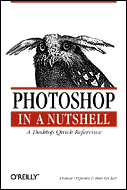 Even
if you do work with imaging programs daily for a living, you never know
it all...and that’s especially true of Photoshop, around which,
incidentally, an entire cottage industry has evolved...books, seminars,
training CDs and tapes, tee-shirts, plug-ins, and more. Adobe’s
made a lot of little people into millionaires...a model of trickle-down
economics at its best. Even
if you do work with imaging programs daily for a living, you never know
it all...and that’s especially true of Photoshop, around which,
incidentally, an entire cottage industry has evolved...books, seminars,
training CDs and tapes, tee-shirts, plug-ins, and more. Adobe’s
made a lot of little people into millionaires...a model of trickle-down
economics at its best.
Economics aside, when I do use Photoshop, I invariably come across a
dialogue box that asks me something I know nothing about and which,
until recently, had me scurrying to scores of Photoshop books to "suss
it out," (as the English say) while wasting much time in the process.
That was until "Photoshop In A Nutshell" (O’Reilly &
Associates) arrived one day for review.
Authors Donnie O’Quinn and Matt LeClair list every menu and dialog
box you’re apt to encounter in Photoshop, concisely explain what
they mean, and then tell you what horrible fate might befall your image
if you click on this or that. It’s really a "desktop quick
reference" (that’s what it’s called) to Photoshop...and
if you’re ever exiled to a desert island with only your laptop,
Photoshop, and one book, this’d be the one to take along. The best
part is that it only costs $20...would you believe that? It’d be
a bargain at three times the price, nay, more!
Product Resources
The following two card readers are for MAC or PC with SCSI. Each has
to be placed at the end of the SCSI chain because they only have one
SCSI port. There are many other PC Card Readers using parallel port
connections to a PC that are priced under $100. Check the web sites
below.
Adtron Corporation - www.adtron.com
Distributed by: Prima International: -
1-800-724-3000
The Accent SPC is a SCSI PC Card Reader, but it requires either a SCSI-2
to DB-25 SCSI cable or a SCSI-2 to SCSI-2 cable plus a SCSI adapter
(NEC Part No.79763029). These will cost $40-$75 extra depending on which
you get. If you already have a cable, this unit is the least expensive
way to go. Call Prima and ask for "Sunny" and the special
ZoneZero price of $199.
Distributed by: EPC-Online: - www.epc-online.com
1-800-310-8505
The PCD-10 is a small, slick, well-designed SCSI PC Card Reader that
includes a SCSI cable so it’s ready to go right out of the box.
Intermart’s main distributor, EPC-Online is offering ZoneZero readers
a $50 discount (just mention ZoneZero) which brings the price to $249.
They also carry adapters and both Compact Flash and SmartMedia memory
cards with five-year warranties.
Lexar Media - www.lexarmedia.com
1-800-789-9418
Some of the best promotions in the flash memory business have been created
by the marketing department of this company. Very attractive (and useful)
goodies are packaged with some of its "digital film"flash
cards. Lexar manufactures both Compact Flash and SmartMedia cards and
adapters and is now striving to manufacture speed demon cards to take
advantage of faster processing times that will be designed into future
digital cameras.
Microtech - www.microtechint.com
1- 800-220-9489 (for where to buy)
This company sells both Compact Flash and SmartMedia cards, readers,
and adapters. They sell a Parallel PC card reader called the "CameraMate"
which takes Type I,II, and III cards and also has a dedicated slot for
Compact Flash cards...at under $100! Complete product information is
at their web site, but they do not sell direct.
Sandisk Corp - www.sandisk.com
(Good information here)
This innovative company invented the Compact Flash card in 1994, and
they’ve put their cards through all kinds of rigorous testing,
including one that went through the wash in an employee’s shirt
pocket and which, they insist, still works. (As the TV saying goes:
Do not try this with your own disk.) Their ImageMate is a neat little
dedicated Compact Flash Parallel port card reader that looks like a
younger, gentler, Moby Dick chomping on a whaleboat plank. Sandisk’s
Compact Flash cards are now guaranteed to provide 10 million images...if
you live that long.
Web Sites
Compact Flash Association - www.compactflash.org
O’Reilly & Associates (Photoshop in a Nutshell) - www.oreilly.com
Emberley Productions (No site yet) 1-415-924-2875; email:
tge@slip.net
OptiCal (Monitor Calibration) - www.colorpar.com
SR, Inc. (DigiSlave Flash) - www.srelectronics.com
Olympus (FlashPath Adapter) www.olympus.com
Excellent Digital Camera Resources
Imaging Resource - www.imaging-resource.com
Digital Camera Resource - www.dcresource.com
Digital
Eyes -
www.image-acquire.com
Steve's DigiCams - www.steves-digicams.com
Arthur Bleich
|


 Click
it open and there are all your camera JPEG image files ready for transfer
to your hard drive. After copying them over, they’re ready to be
opened in your imaging program. Some imaging programs will even read
them directly from the PC Card Reader and import them as thumbnails...just
as if they were still in your camera which, in a manner of speaking,
they are. When you’ve completed the transfer -about a second or
two per MB- and verified that your pictures are really there, you can
erase the card and you’re ready to roll again. You can also give
it a name other than "Untitled" if you wish.
Click
it open and there are all your camera JPEG image files ready for transfer
to your hard drive. After copying them over, they’re ready to be
opened in your imaging program. Some imaging programs will even read
them directly from the PC Card Reader and import them as thumbnails...just
as if they were still in your camera which, in a manner of speaking,
they are. When you’ve completed the transfer -about a second or
two per MB- and verified that your pictures are really there, you can
erase the card and you’re ready to roll again. You can also give
it a name other than "Untitled" if you wish. The whole point behind this unusual product is that it is supposed to
save you lots of money on memory cards. For example, when you go on
vacation you need only use the memory card that came with your camera
and, when it’s full, dump the images into the wallet, erase your
card, and use it for new pictures. The Wallet uses serial transfer,
which is slow as molasses and so you’d want to put it to work while
you went to dinner each evening. When the transfer is complete, you
hit a button and it confirms that everything went OK. Once home, you
use the supplied software to download the images from the Wallet to
your computer...better plan on a seven-course meal that evening, unless
you’ve taken 10,000 pictures, in which case a week-long feast would
be more in order.
The whole point behind this unusual product is that it is supposed to
save you lots of money on memory cards. For example, when you go on
vacation you need only use the memory card that came with your camera
and, when it’s full, dump the images into the wallet, erase your
card, and use it for new pictures. The Wallet uses serial transfer,
which is slow as molasses and so you’d want to put it to work while
you went to dinner each evening. When the transfer is complete, you
hit a button and it confirms that everything went OK. Once home, you
use the supplied software to download the images from the Wallet to
your computer...better plan on a seven-course meal that evening, unless
you’ve taken 10,000 pictures, in which case a week-long feast would
be more in order. His
2.4 amp-hour battery pack is the only one that uses environmentally
safe, rechargeable NiMH (Nickel Metal Hydride) batteries that last 8-times
longer than a set of standard AA’s. They can be recharged 1,000
to 2,000 times and will just keep on tickin’ or jucin’ as
the case may be, and each has a custom cord to fit your camera model.
Even more powerful 4 and 8 amp-hour packs are coming soon, and they’ll
all double as AC power supplies so you can save a bundle there.
His
2.4 amp-hour battery pack is the only one that uses environmentally
safe, rechargeable NiMH (Nickel Metal Hydride) batteries that last 8-times
longer than a set of standard AA’s. They can be recharged 1,000
to 2,000 times and will just keep on tickin’ or jucin’ as
the case may be, and each has a custom cord to fit your camera model.
Even more powerful 4 and 8 amp-hour packs are coming soon, and they’ll
all double as AC power supplies so you can save a bundle there.

 Even
if you do work with imaging programs daily for a living, you never know
it all...and that’s especially true of Photoshop, around which,
incidentally, an entire cottage industry has evolved...books, seminars,
training CDs and tapes, tee-shirts, plug-ins, and more. Adobe’s
made a lot of little people into millionaires...a model of trickle-down
economics at its best.
Even
if you do work with imaging programs daily for a living, you never know
it all...and that’s especially true of Photoshop, around which,
incidentally, an entire cottage industry has evolved...books, seminars,
training CDs and tapes, tee-shirts, plug-ins, and more. Adobe’s
made a lot of little people into millionaires...a model of trickle-down
economics at its best.